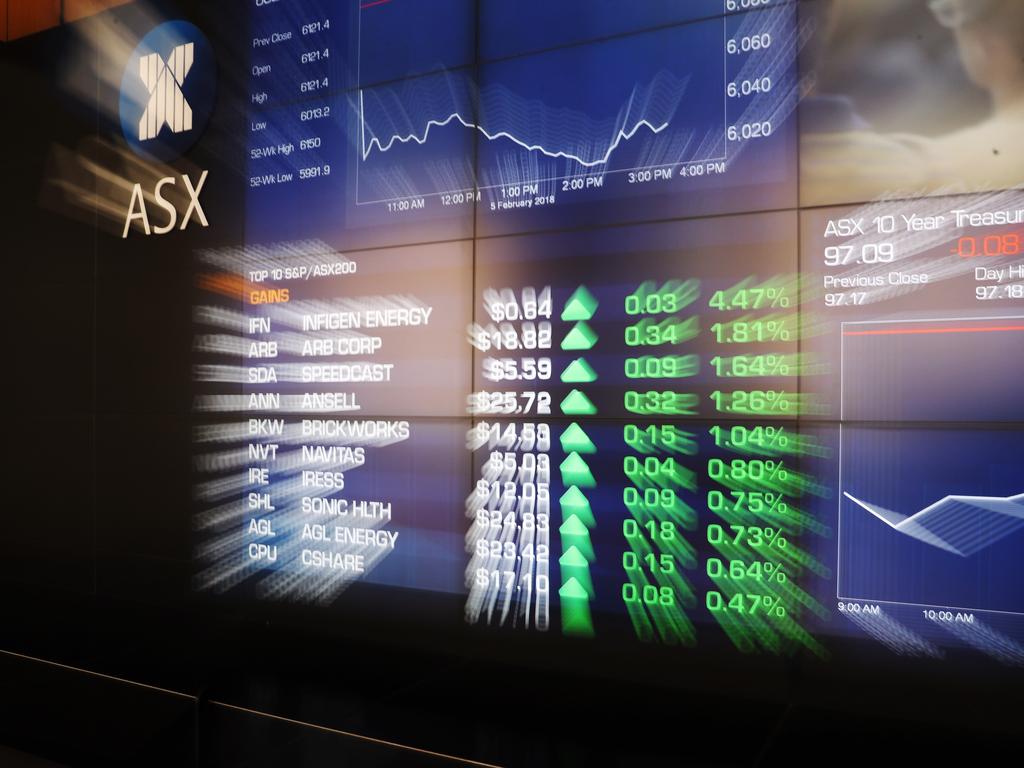‘Solid’ super returns tipped for 2020: SuperRatings
Super fund returns have had their best year since 2013, but investors are being urged to temper expectations for 2020.

A bumper year for equities powered super fund returns to their best year since 2013, but investors have been urged to temper expectations of a repeat of double-digit gains over the coming 12-months.
Median balanced superannuation funds returned 13.8 per cent over calendar 2019, the best gains in five years, according to research house SuperRatings.
The performance, driven by large gains in Australian and international equities on ultra-low interest rates, translates to average super funds returns of 7.7 per cent over the past decade.
The figures come as the Australian sharemarket on Wednesday again came within striking range of the key 7000-point barrier. The benchmark S&P/ASX 200 index closed at 6994.80 points, up 0.5 per cent for the session.
Despite a sell-off in Australian shares in December, super funds entered the new year in a stronger position with markets optimistic that geopolitical tensions, particularly around the China-US trade war, would ease.
However, even with low interest rates funds are already battling the new normal of lower yields and returns, which will make a repeat of 2019’s results unlikely in 2020.
“We’re anticipating a solid year for super in 2020, but the key challenge for funds will be the low return environment,” said SuperRatings executive director Kirby Rappell.
“Even with the possibility of a pick-up in economic growth, yields are extremely low and it’s getting harder to find opportunities in the market”.
“Company earnings growth is slowing, and Australian consumers are under pressure, so fundamentally it will be more challenging than 2019. That doesn’t mean it will be a bad year, but super members should not expect to bank another 13 per cent,” he said.
The $70bn industry fund SunSuper expects growth to be in the single digits in the coming year.
Speaking to The Australian, SunSuper chief investment officer Ian Patrick said current “healthy returns” from equities were unsustainable while global growth remained under a cloud.
“Global growth is positive but not very strong,” he said. “There is enough geopolitical headwinds to anticipate some volatility.”
Still, he said SunSuper’s objectives of delivering real growth in savings will continue to be met “comfortably” in the next two years.
“We don’t have to overreach (in investment returns) for fear of missing out that last little bit of an equity bull run,” he said.
This week establishment fund manager Mirrabooka warned sky-high equity valuations mean companies that disappoint in the upcoming profit season will be “savaged”.
Mirrabooka managing director Mark Freeman warned that companies — especially those in the mid-tier space — now had to justify their lofty valuations.
SuperRatings said the median growth super funds option returned an estimated 16 per cent over the year, while the capital stable super option, which is skewed to lower risk investments such as bonds, returned an estimated 7 per cent for the year.
For balanced funds – which are a blend of growth and capital stable options – the performance of the past year saw super funds return 8.1 per cent over three years and 7.4 per cent over five years. The one-year return of 13.8 per cent is the fourth-highest over the past two decades.
Even with the steep losses recorded through the global financial crisis, over a 15-year period the median balanced super option, with a starting balance of $100,000, would have grown to an estimated $259,340 by the end of 2019, SuperRatings calculates. This represents a return of 159.3 per cent.
Top balanced fund performers, including fees, over a 10-year period were industry funds AustralianSuper and Hostplus on 9.4 per cent, UniSuper on 9.1 per cent and Cbus with returns of 9 per cent.
After the volatility of 2018, super funds saw steady growth in 2019 with only three down months during the year. The largest fall in the median balanced option was 0.9 per cent in December.
The main drivers of performance typically come from equities, of which Australian shares generally make up the greatest proportion.
The Australian share market delivered a return of 18.4 per cent, while international shares delivered 25.4 per cent unhedged or 25.8 per cent hedged in Australian dollars. Listed property returned 14.2 per cent and fixed interest – another major asset class for funds – returned 4.4 per cent, while cash returned a meagre 1.5 per cent.
SuperRatings’ Mr Rappell said that alternatives – including private equity – are increasingly important as an asset class for superfund returns, although market-based measures of performance are harder to determine.
He also predicted a further wave of mergers after a number of high-profile mergers in 2019.
“A key driver of mergers will be the sustainability of operating expenses, which is a challenge for some funds across all size categories,” Mr Rappell said.
“Though, smaller funds are more likely to have a high cost per member and management expense ratio, which measure the operational costs of the fund relative to its size.”
Mr Rappell noted that with increased regulatory scrutiny of the sector after the recent royal commission, funds are focused on the challenge of increasing scale and driving down fees.
“It’s pleasing to see that there’s a clear focus among providers on their plans to adapt to the changing landscape, which should support continued uplift in member outcomes,” he said.
“However, there remain a number of providers who are struggling to deliver sufficient value for money and the industry’s ability to address this is critical.”
APRA released its MySuper Heatmaps in December which highlighted laggards based on investment returns, fees and sustainability metrics and emphasised a tougher approach going forward.
APRA also now has stronger powers to force underperforming funds to merge, which is likely to further drive consolidation across the industry.
SunSuper’s Mr Patrick said investments in banks tend to be “lead in the saddle bags’ of the domestic market will continue to drag down the financial index, primarily through constraints on credit assessments.
A “relatively low risk” of recession in Australia, “accommodative” monetary policy and an emerging need of fiscal support is likely to assist in generating growth in the domestic economy.
“The clear evidence monetary policy will remain accommodative, where support for sentiment and confidence in markets is paramount in the minds of central bankers,” Mr Patrick said.






To join the conversation, please log in. Don't have an account? Register
Join the conversation, you are commenting as Logout